“[Cavanaugh’s] figures’ lithe, almost feline physiques evoke the work of Degas. So does his impressionistic ability to capture his subjects in private, unexpected moments...”
- Jordan Gentile, Columbus Other Paper - Feb 10, 2005
John William Cavanaugh, Sculptor
About the Sculptor
John William Cavanaugh, "the 20th century's master of hammered lead," was born in Sycamore, Ohio, on September 20, 1921. The third of four sons, of intensely religious, poor and rural parents, John was perceived to possess unusual creative talent very early. Premature hardships, the death of his father, Chauncy Floyd Cavanaugh, to suicide in 1929, frail health, partial hearing loss, and the onset of the Great Depression, while particularly dreadful, may have also equipped him with rare courage.
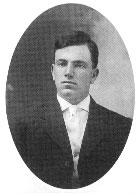
|

|
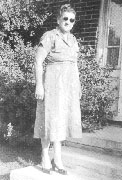
|
John's mother, Hilda, acknowledging his talent, seeing no art classes offered in Sycamore schools and possibly in hopes of one son becoming a priest, sent him to the Ursulan convent in Tiffin, Ohio, to study. Though Cavanaugh later described it as a "horrible experience," it began a sequence of art training within religious confines that would have considerable influences on him throughout his life.
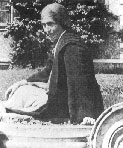
In 1938, again at Hilda's direction, Cavanaugh went to live and study art in Urbana, Ohio, under the authority of Alice Archer Sewall James (1870-1955). Mrs. James, founder of the Urbana Movement, ran a school of classic art instruction interspersed with the beliefs and readings of the Swedenborgian Church. Pious through and through, James once gave a lecture, from her sick bed (suffering a bad case of hives), after hearing of the "goings ons" between male and female students at the school. In this lesson she stated with a "sense of joy and triumph" she had "been permitted this trial of temptation to touch herself in order to resist for all of them the lust of touching."
 Taught to draw from cast and paint in oils, in time Cavanaugh expanded his study to sculpture, excelling in several media. Mrs. James treated him with firm care and is said to have considered him more a son, than she did her own. Her empathy for his partial deafness prompted her to say he had "a wonderful mind and heart shut in, almost without verbal expression from the early lack of hearing." After five years of intense instruction, concerned his spelling would "handicap him all of his life," in 1942, James gave Cavanaugh one hundred dollars, aiming him toward college to "learn how to write."
Taught to draw from cast and paint in oils, in time Cavanaugh expanded his study to sculpture, excelling in several media. Mrs. James treated him with firm care and is said to have considered him more a son, than she did her own. Her empathy for his partial deafness prompted her to say he had "a wonderful mind and heart shut in, almost without verbal expression from the early lack of hearing." After five years of intense instruction, concerned his spelling would "handicap him all of his life," in 1942, James gave Cavanaugh one hundred dollars, aiming him toward college to "learn how to write."
Cavanaugh registered at Ohio State University initially studying English Composition and Literature, then during his second and third years, he enhanced his curriculum with sculpting courses, receiving his undergraduate degree in 1945.
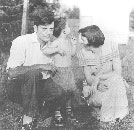
In 1946 Cavanaugh married Janet Corneille, in Columbus, Ohio. Soon after the wedding they moved to Boston where John studied at the Swedenborgian Theological School in Cambridge, under the Reverend Franklin Blackmer (president Urbana College 1926-32). In 1947, Janet became pregnant. Nine months later, suffering with hydrocephalic syndrome their baby boy died, shortly after birth. Grieving the death of their child, and struggling with growing disillusion and conflict with the Rev. Blackmer and the church, the Cavanaugh's returned to Ohio, taking up residence in Columbus.
In 1948, John and Janet moved again, to Iowa City, Iowa. John enrolled full time at the University of Iowa to study engraving and sculpture and worked at the University Hospital to make ends meet. The following year, Janet gave birth to a healthy baby boy, who they named Jon. Soon after Jon's birth, Cavanaugh fell ill with pneumonia and injured himself falling off a bus. Weak and exhausted, he took his family to Upper Sandusky, Ohio, to recover at his mother's. Hilda and her second husband Maurice, "Shorty," who was her deceased husband's brother, had built the house from plans John designed as a teenager. The house still stands today on North Warpole Street. John took a job in a land mine factory and managed to support his family.
 In 1951, resolving to further his education, Cavanaugh re-enrolled at Ohio State. Largely working in ceramic he also experimented with cement, cast stone, aluminum, wood, sheet metal and sheet copper. That year he was awarded a National Sculpture Society Purchase Prize at the National Ceramics Show, for his sculpture Goose, now in the Everson Museum at Syracuse University. Following that honor he was offered a grant to attend Cranbrook Academy, in Bloomfield Hills, Michigan, though unable to accept for financial reasons, the recognition was "exactly what I needed," Cavanaugh said, arousing a surge of work he truly called his own.
In 1951, resolving to further his education, Cavanaugh re-enrolled at Ohio State. Largely working in ceramic he also experimented with cement, cast stone, aluminum, wood, sheet metal and sheet copper. That year he was awarded a National Sculpture Society Purchase Prize at the National Ceramics Show, for his sculpture Goose, now in the Everson Museum at Syracuse University. Following that honor he was offered a grant to attend Cranbrook Academy, in Bloomfield Hills, Michigan, though unable to accept for financial reasons, the recognition was "exactly what I needed," Cavanaugh said, arousing a surge of work he truly called his own.
In 1955 Cavanaugh had his first one-man exhibitions, at Antioch College and the Cranbrook Academy. These exhibitions promoted his growing reputation, with added recognition coming in the form of a faculty position at the Columbus Museum School where he taught clay modeling. Noverre Musson wrote in the catalogue for John's Antioch show, "He has an imagination which conceives unthought-of techniques for fabricating the forms he visualizes." His often abstracted designs "magnified the essential concept," offering an expression "strongly individual"; attributable, Musson believed, to Cavanaugh's eclectic training as first a painter and later as a ceramist and sculptor. During this time Cavanaugh also began producing sculptures of large headed children which he recognized, in retrospect, as references to his first born child. With their enchanting and equally haunting effect, the artist through the 1960's and 1970's repeated these sculptures. "Everybody loved them," he recalled.
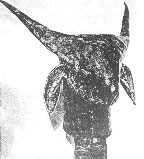
In 1954, Cavanaugh created his first piece with hammered metal, Goat Head. Winning the highest honor at the Columbus Art League Annual Exhibition, it was again seen that year at the Eighth Annual Ohio Ceramic and Sculpture Exhibition. North American Aviation, where John worked and obtained the metal for Goat Head, made note of the piece in their newsletter. TakeOff, NAA's newsletter, proudly noted "Experimental worker here at the plant, John Cavanaugh, recognized local sculptor and painter, is the guest artist tonight in the Columbus Gallery of Art's 'Meet the Artist' series... [his award winning Goat Head] was formed "from a piece he obtained incidentally, from the NAA Salvage Yard Department." Another benefit of his job at NAA was finally being able to afford studio space in Columbus. Studio mate Laura Ziegler, a distinguished artist whose work is held in the collections of the Museum of Modern Art and the Hirshhorn, among others, recalls he "tore in there and worked and worked and worked with incredible facility." She remembers he was without a doubt an "extraordinary artist," and "a master of technique."
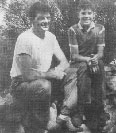
1956 was full of torment for Cavanaugh. With growing doubts about his sexuality, his marriage, his art and religious beliefs, he was traumatized by his battle to stay true to Janet, his son, his family, himself, and his religious training. The ensuing guilt reeked havoc on his spirit. and that September John Cavanaugh caught a bus for New York, leaving his wife, son, extended family and friends behind. His mother disowned him, sought to turn his brothers against him and he never saw her again. Only after her death was he able to renew his close relations with his brothers. For His wife, Janet, at least said in retrospect, John was "a man who was very strong in many ways but never had the chance to direct it the right way till later in life." They kept in touch, and she frequently expressed her faith in him as an artist. Their son Jon's love remained strong for Cavanaugh. He was never angry with his father because he'd "never felt abandoned."
Cavanaugh's hosts in New York, old friends from Ohio, once hearing Cavanaugh's avowal of his struggles said, "you could not help but reach out." Once settled on Staten Island, John sent for his son who attended first grade while living with his father. Cavanaugh realized he was in no position to care for Jon and took the "traumatic" step of having him sent back to Ohio. John supported himself by producing window dressings for Resident Display in Greenwich Village, and worked part time as an industrial designer producing and delivering hair curlers. Artists Alice Beardsley Carroll and Ruth Jacobson, also working at the display house both recall his emotional turmoil. "He was very troubled," and thought he was "very evil," said Alice Carroll, "and what I did was listen and not be impressed by this 'evil'. I kept saying there are worse things; what you've done is nothing." Jacobson recalls that for the display house he was doing "enormous murals," "amazing splashy works... and that really helped him."
During that first year in New York John wrote regularly in private notebooks and journals. He felt a pattern of thought that was like "old worn clothes, I cannot dump or wear..." He re-established his contact with Rev. Blackmer, sending a letter expressing his sense of conflict over desires to acknowledge his own sexuality, and creative drive, as well as the divinity of Christ. Cavanaugh wondered did Christ, "separate sex and love?" Cavanaugh claims that during this time his self-inhibition was so strong that he could neither sculpt or sleep.
Several months after his arrival Cavanaugh met Dorothea Denslow (1900-1971) who in 1928 founded the New York Sculpture Center in Brooklyn and remained acting Director. In return for firing the kiln and cleaning the Center, Denslow allowed studio space usage free of charge, where he devoted spare time to sculpting in terracotta. By January of 1958 his self confidence was "growing by leaps and bounds," and he found himself "emerging quite a different sculptor than I thought I would be." In a letter to a friend he wrote "lately I have started to [make] sculpture again, to dream again of a future, and to reorganize attitudes or convictions." Then in 1959, he made the acquaintance in the village of Philip Froeder, then an architecture student at Columbia. They soon became partners and remained so until Cavanaugh's death.
 During the early 1960's Cavanaugh found the financial means to produce bronze castings of his terracotta works. Generally a single cast was made, though on occasion he produced an edition of three or four castings. In 1962, Cavanaugh found lead. At first daunted by the medium he soon developed techniques permitting him to produce sculptures faster then he could mold clay and providing the impetus to expand his work to life-size proportions without fear of prohibitive cost. Beyond cost and scale, more artistic influences most surely were the somewhat older artists Jose de Creeft, who made hammered lead portraits, and Sal Baizerman, whose mammoth works in copper inspired countless artists. Cavanaugh grew close to Nina Winkel during this time, a sculptor in hammered copper who had been exhibiting at the Sculpture Center since 1944. Winkel became an increasingly important influence and support to him. And Dorothea Greenbaum, a highly accomplished sculptor working in hammered lead, considered Cavanaugh a "tour de force" in the genre of pounded lead sculpture.
During the early 1960's Cavanaugh found the financial means to produce bronze castings of his terracotta works. Generally a single cast was made, though on occasion he produced an edition of three or four castings. In 1962, Cavanaugh found lead. At first daunted by the medium he soon developed techniques permitting him to produce sculptures faster then he could mold clay and providing the impetus to expand his work to life-size proportions without fear of prohibitive cost. Beyond cost and scale, more artistic influences most surely were the somewhat older artists Jose de Creeft, who made hammered lead portraits, and Sal Baizerman, whose mammoth works in copper inspired countless artists. Cavanaugh grew close to Nina Winkel during this time, a sculptor in hammered copper who had been exhibiting at the Sculpture Center since 1944. Winkel became an increasingly important influence and support to him. And Dorothea Greenbaum, a highly accomplished sculptor working in hammered lead, considered Cavanaugh a "tour de force" in the genre of pounded lead sculpture.
In 1963 he had his first one-man show at the Sculpture Center, consisting of 47 works in lead, bronze and terracotta. Reviews of the show were unreservedly positive. The Times praised his "Graceful and emotionally subtle figures" and his "fresh poses, almost catching the figure unaware." The Herald Tribune likewise praised his figures for an "arresting self-containment that is never cold, never awkward," "charged with emotion" and "leap[ing] to life through an expert and palpable technique and through the artist's own concern with the subtleties of personal involvement."
That same year, with Philip having been offered a job with an Urban Planning firm in Washington, DC, John decided to move with him. Continuing to travel to New York frequently, Cavanaugh found Washington to be a well-suited environment. He said he "produced like he had never produced in his life." With studios in the neighborhood of Dupont Circle they served as both workshop and exhibition space. His first studio show, in 1964 led to major commissions, allowing him to avoid taking other work. Cavanaugh presented twice yearly studio exhibitions from 1964 through 1984 in Washington; amounting to 800 pieces in lead, ceramic stoneware and bronze, of which 200 were life sized. He staged five additional one-man shows in New York at the Sculpture center (1968, 1971, 1973, 1975, 1978), single shows at Ohio State (1964), Ball State University (1976), among others. In addition he exhibited regularly with the National Sculpture Society in New York, which to this day awards the John Cavanaugh Silver Award on an annual basis. He was the recipient of numerous awards and honors, including the 1984 New York Foundry Prize of the National Sculpture Society.
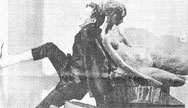
Adding to the income of his art John would also act as foreman on many of the restoration projects carried out by Philip. His lead sculpture, as a result, came to adorn public spaces and the facades and walks of homes in Washington, which can still be seen today. He was sought out for large commission work for an assortment of clients, to include the Marriott, which bought several major works, the Landmark Corporation and the Crown Tower apartment complex in New Haven, Connecticut, among others. One of his large female figures, Reclining Female was featured in the movie The World of Henry Orient starring Peter Sellers.
Though living in Washington may have distanced Cavanaugh from the center of gravity in the art world, as New York was seen to be, it did keep him away from the time-consuming politics of the art world and galleries, allowing him to focus on the output and innovation of his work, and he obviously thrived.
In the early 1980's John was diverted by illness, found to be related to cancer from working in lead. During his last two years, Cavanaugh worked with intensity and zeal. By June of 1984, he was depleted of the "tons and tons of energy" required to hammer the lead into shape. With typical self-sufficiency, he turned his attention to a specialized sort of glass painting, and sculpting directly in a combination of plastic and wax, molding pieces to be cast in bronze by the lost wax process. Five months later in December he had produced over seventy wax models for casting in bronze, including five life-sized pieces.
John Cavanaugh died in 1985, leaving his sculpture to express the courage, spirituality, optimism, and vitality, which were the essential qualities of the man and his work. His last letter to Nina Winkel ends with "It's time for me to go."
During his last days John was once again planning an exhibition. He intended to call it "The Spirit of Motion is Almost Balanced." Philip Froeder did hold that exhibition in honor of John's wishes, as a tribute to his life and work and as a way to honor his many friends.
He is remembered by all who knew him as a warm, outgoing and spontaneous individual. He shared his insight and humor freely, drawing people from all walks of life into his creative world. Joan Gildemeister, now president of the Cavanaugh Foundation marveled at his generosity in recalling how he "shared his creativity with his friends, letting us in" to his studio and life.
The complete "In Search of Motion: John Cavanaugh / Sculptor (1921-1985)" Biography and Catalogue Raisonné is available for purchase from the John Cavanaugh Foundation, in Washington DC.
Limited pieces of John Cavanaugh's work are available for private and public purchase through the John Cavanaugh Foundation. Founded by his life partner, Philip Froeder, the foundation seeks to promote and support the work and ideas John Cavanaugh through promotion and sale of the visionary work created by this extraordinary artist.
The Cavanaugh Foundation would like to thank the friends and family, living and deceased, of John Cavanaugh for their unselfish contributions to the complete Catalogue Raisonné and for their generous contribution to his life and his work.